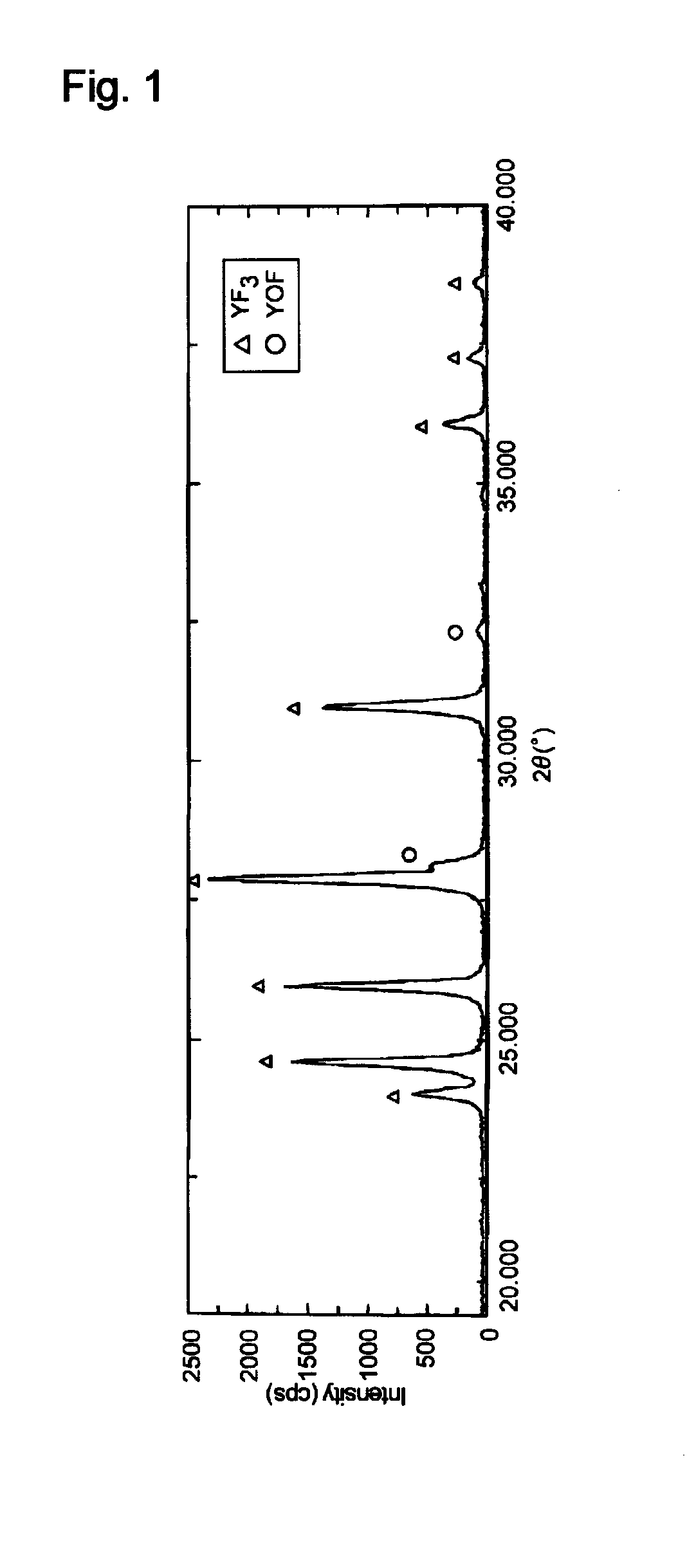Thermal spray material and process for preparing same
a technology of thermal spray coating and thermal spray coating, which is applied in the direction of molten spray coating, coatings, chemistry apparatus and processes, etc., can solve the problem that the flowability cannot be said to be sufficiently satisfactory, and achieve the effect of preventing the reduction of the anti-corrosive properties of the thermal spray coating, smoothing the thermal spray coating with ease, and reducing the anti-corrosive properties of the resulting thermal spray coating
- Summary
- Abstract
- Description
- Claims
- Application Information
AI Technical Summary
Benefits of technology
Problems solved by technology
Method used
Image
Examples
example 1
[0050]A thermal spray material consisting of YOF and YF3 was produced according to the following procedures (a) through (d).
(a): Step 1
[0051](a-1) Wet Synthesis of Yttrium Fluoride
[0052]In 400 L of pure water being stirred was poured 300 kg of 99.9% yttrium oxide to prepare a slurry. To the slurry was added 550 L of a 15 mol / L aqueous solution of nitric acid at a rate of 5 L / min, and the stirring was further continued for an additional period of 30 minutes. The slurry was filtered in vacuo to give 1100 L of a solution containing 270 g (in terms of Y2O3) of a solute per liter.
[0053]To the solution being stirred was added 300 L of 50% hydrofluoric acid at a rate of 5 L / min to form a precipitate of yttrium fluoride. Sedimentation of the precipitate, removal of the supernatant, addition of pure water, and repulping were conducted twice, followed by sedimentation, and followed by removal of the supernatant. The resulting wet solid was placed in a polytetrafluoroethylene tray and dried at...
example 12
[0060]Example 12 demonstrates the production of a thermal spray material having part of yttrium displaced with a rare earth element (Ln) except yttrium.
(a): Step 1
[0061](a-1) Wet Synthesis of Yttrium Samarium Fluoride
[0062]A mixture of yttrium oxide and samarium oxide was used in place of the yttrium oxide used in step 1 of Example 1. The mixing ratio of the two was as shown in Table 2. The mixture was poured into 40 L of pure water being stirred to prepare a slurry. To the slurry was added 55 L of a 15 mol / L aqueous solution of nitric acid at a rate of 5 L / min, and the stirring was continued for an additional period of 30 minutes. To the resulting solution being stirred was added 30 L of 50% hydrofluoric acid at a rate of 5 L / min to form a precipitate. Sedimentation of the precipitate, removal of the supernatant, addition of pure water, and repulping were conducted twice, followed by sedimentation, and followed by removal of the supernatant. The resulting wet solid was placed in a ...
examples 13 to 16
[0065]Examples 13 to 16 demonstrate the production of thermal spray materials in which part of yttrium is displaced with a rare earth element (Ln) except yttrium similarly to Example 12. A desired thermal spray material was produced in the same manner as in Example 12, except for replacing samarium used in step 1 with the rare earth element oxide shown in Table 2 in the mixing ratio shown.
TABLE 2Rare earth elementLn2O3Y2O3Ln molar fractionLn(kg)(kg)(%)Example 12Sm4.63270.1Example 13Gd4.82270.1Example 14Dy4.96270.1Example 15Er5.08270.1Example 16Yb5.24270.1
Evaluation:
[0066]The thermal spray materials obtained in Examples and Comparative Examples were evaluated for granule fracture strength and oxygen content by the methods described supra. The thermal spray materials were analyzed by X-ray diffractometry, and the relative intensity of main peaks of each of YF3, YFO, and Y2O3 was calculated from the diffraction pattern. As a representative, the X-ray diffraction pattern of the thermal ...
PUM
| Property | Measurement | Unit |
|---|---|---|
| fracture strength | aaaaa | aaaaa |
| fracture strength | aaaaa | aaaaa |
| particle size | aaaaa | aaaaa |
Abstract
Description
Claims
Application Information
 Login to View More
Login to View More - R&D
- Intellectual Property
- Life Sciences
- Materials
- Tech Scout
- Unparalleled Data Quality
- Higher Quality Content
- 60% Fewer Hallucinations
Browse by: Latest US Patents, China's latest patents, Technical Efficacy Thesaurus, Application Domain, Technology Topic, Popular Technical Reports.
© 2025 PatSnap. All rights reserved.Legal|Privacy policy|Modern Slavery Act Transparency Statement|Sitemap|About US| Contact US: help@patsnap.com

